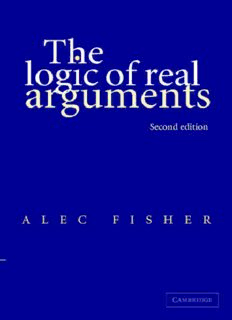Table Of ContentThe Logic of Real Arguments
ThisnewandexpandededitionofTheLogicofRealArguments
explainsadistinctivemethodforanalysingandevaluating
arguments.Itdiscussesmanyexamples,rangingfromnewspaper
articlestoextractsfromclassictexts,andfromeasypassagesto
muchmoredifficultones.Itshowsstudentshowtousethe
question‘Whatargumentorevidencewouldjustifymein
believingP?’,andalsohowtodealwithsuppositionalarguments
beginningwiththephrase‘SupposethatXwerethecase.’Itaims
tohelpstudentstothinkcriticallyaboutthekindofsustained,
theoreticalargumentswhichtheycommonlyencounterinthe
courseoftheirstudies,includingargumentsaboutthenatural
world,aboutsociety,aboutpolicyandaboutphilosophy.Itwillbe
valuableforstudentsandtheirteachersinawiderangeof
disciplinesincludingphilosophy,lawandthesocialsciences.
Alec Fisher
SchoolofEconomicandSocialStudies
UniversityofEastAnglia
The
logic
of
real
arguments
cambridge university press
Cambridge,New York, Melbourne, Madrid, Cape Town, Singapore, Sa~o Paulo,
Delhi, Tokyo, Mexico City
Cambridge University Press
TheEdinburghBuilding,Cambridge,CB28RU,UK
Published in the United States of America by Cambridge University Press, New York
www.cambridge.org
Information on the title: www.cambridge.org/9780521654814
Firstedition(cid:2)C CambridgeUniversityPress1988
Secondedition(cid:2)C AlecFisher2004
Thispublicationisincopyright.Subjecttostatutoryexception
andtotheprovisionsofrelevantcollectivelicensingagreements,
noreproductionofanypartmaytakeplacewithout
thewrittenpermissionofCambridgeUniversityPress.
Firstpublished1988
Secondedition2004
9th printing 2012
PrintedintheUnitedKingdomattheUniversityPress,Cambridge
AcataloguerecordforthispublicationisavailablefromtheBritishLibrary
ISBN978-0-521-65241-4Hardback
ISBN978-0-521-65481-4Paperback
Cambridge University Press has no responsibility for the persistence or accuracy
of URLs for external or third-party internet websites referred to in this publication,
and does not guarantee that any content on such websites is, or will remain,
accurate or appropriate. Information regarding prices, travel timetables and other
factual information given in this work are correct at the time of first printing but
Cambridge University Press does not guarantee the accuracy of such
information thereafter.
Contents
Prefacetothefirstedition vii
Prefacetothesecondedition x
Acknowledgements xi
1 . Introduction 1
2 . Ageneralmethodofargumentanalysis 15
3 . Afirstexample–fromThomasMalthus 29
4 . Reasoningaboutnucleardeterrence 48
5 . AnexamplefromJohnStuartMill 70
6 . ArgumentsaboutGod’sexistence 82
7 . Howdoyourmindandbodyinteract? 99
8 . Supposeforthesakeofargumentthat... 115
9 . AnexamplefromKarlMarx 132
10 . Evaluating‘scientific’arguments.Someinitial
examples 143
11 . Philosophicalassumptions 160
Appendix . Elementaryformallogic 172
Exercises 188
Bibliography 219
Listoffurtherreading 221
Index 222
v
Preface to the first edition
Thisbookaroseoutofmyexperienceofteachinglogic.LikemanyothersI
hopedthatteachinglogicwouldhelpmystudentstoarguebetterandmore
logically.Likemanyothers,Iwasdisappointed.Studentswhowerewellable
tomasterthetechniquesoflogicseemedtofindthatthesewereofverylittle
helpinhandlingrealarguments.Thetoolsofclassicallogic–formalisation,
truth-tables, Venn diagrams, semantic tableaux, etc. – just didn’t seem to
applyinanystraightforwardwaytothereasoningwhichstudentshadtoread
incoursesotherthanlogic.AtthesametimeIfeltthatitoughttobepossible
togivestudentssomeguidance–someprocedure–whichwouldhelpthem
to extract and to evaluate arguments from written texts and which would
helpthemtowritegoodargumentsoftheirown.Iwantedtheprocedureto
benon-formalbuttobuildupontheinsightsoftraditionallogic;thisbook
attemptstorealisethatobjective.
Manyotherteachersoflogicandphilosophyhavehadmuchthesameexpe-
rienceinthepasttwodecadesandtheresulthasbeentheemergenceofwhat
isnowcalledthe‘informallogicandcriticalthinkingmovement’inNorth
America. One of the first books in this tradition was Monroe Beardsley’s
Practical Logic, a book which is still well worth reading over thirty years
on.StephenToulmin’sTheUsesofArgumentisanotherclassicattemptat
providinganalternativeframeworkforunderstandingreasoning.However,
MichaelScriven’sReasoninghasprobablybeenthemostinfluentialcontri-
butiontothefield:itmarksawatershedsincewhichinterestinthesubject
hasgrownveryrapidly.Foraveryusefulbibliography,seeInformalLogic:
The First International Symposium, edited by J. Anthony Blair and Ralph
H.Johnson.
TheLogicofRealArgumentsisacontributiontotheliteratureinafield
whichisalreadyveryextensiveanditmakesnoattempttobecomprehensive.
However,itisdistinctiveinvariousways.Forexamplethefocusofinterest
is not so much on everyday reasoning as on theoretical argument of the
kind that university and college students encounter in the course of their
work.Thebookconsidersmainlysustainedtheoreticalargumentsaboutthe
naturalworld,aboutsociety,aboutpolicyoraboutphilosophy–thesortof
argumentwhichiscomplex,importantbuthardtohandle.
The general method of argument analysis which is presented (see espe-
cially Chapter 2) is intended to apply to a wide range of such written
vii
Prefacetothefirstedition
arguments–expressedinordinarylanguage.Themethodemploysdiagram-
mingtechniquestorepresentthestructureofarguments,andanalternative,
linearrepresentation,isprovidedforthosewhohatediagrams.However,the
distinctivefeatureofthemethodexplainedhereisitsuseoftheAssertibility
Question,
What argument or evidence would justify me in asserting the
conclusionC?
Thisquestionisusedbothindiscoveringanauthor’sintendedargumentand
inevaluatingthatargument.Itisusedanddiscussedextensivelythroughout
thebookandthephilosophicalassumptionsunderlyingitsuseareexplained
inChapter11.
Anotherdistinctivefeatureofthisbookisitstreatmentof‘suppositional
reasoning’. Most informal logic/critical thinking texts make no mention
of this at all (though Stephen Thomas’s Practical Reasoning in Natural
Language (3rd edn) is a notable exception). The reasoning considered in
mosttextsemploysonlyassertions,i.e.propositionswhichhavebeenpre-
sented as being true. However, many arguments (particularly in theoret-
ical contexts) reach their conclusion not by asserting their starting points
but by assuming or supposing something ‘for the sake of argument’ – as
whenanatheistsays,‘SupposethereisaGod...’InChapter8weexplain
howtohandlesuchreasoningandhowtodiagramit,usingideasdueorigi-
nallytoGottlobFrege.Thisnecessitatesrevisingwhatisnormallysaidabout
reason and conclusion indicators; these are systematically ambiguous in a
waythatmosttextsfailtonotice.
Since it will be clear that many of the theoretical contexts in which we
are interested are scientific or pseudo-scientific we also have a chapter on
scientific argument. This involves giving an account of Hume’s ideas on
the role of observation and induction, of Popper’s conception of scientific
methodintermsofconjecturesandrefutationsandofThomasKuhn’swork
on paradigms, normal science and scientific revolutions. Since the message
ofthisbookisthatonecannotescapeepistemology(inevaluatingreasoning)
theteacherwhowishestoemploytheapproachofthisbookfurtherin,say,
the historical domain might wish to supply a similar chapter on historical
method.
Muchofthebookconsistsindiscussingparticularexamplesofreasoning:
the sources range from Thomas Malthus to Karl Marx and from Caspar
Weinberger to Charles Darwin. There is also an Appendix which outlines
some of the basic ideas of classical elementary formal logic. This contains
an extensive explanation of the notion of (deductive) validity in terms of
thenotionof‘logicalform’(logicalstructure).Furthermore,thenotationof
propositionalandpredicatelogic,truth-tablesandsemantictableauxareall
introducedinsofarastheyarerelevanttowhathasgonebefore.Thebook
concludeswithalargenumberofcarefullyselectedexercises.Thosewhoare
viii
Description:This new and expanded edition explains a distinctive method for analyzing and evaluating arguments. It features many examples, ranging from newspaper articles to extracts from classic texts, and from easy passages to much more difficult ones. It will enable students to think critically about sustain

